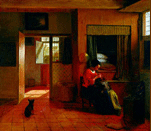










18.
Hysteria, the Passions, and Suffocation of the Mother
Organizers:
Description:
There will be three facilitators, Elspeth Whitney, Alison Klairmont- Lingo
and Laurinda Dixon. Each will make a short initial presentation (6-7 minutes)
and introduce to the group one or two questions or issues relating their own
material to that of the other members of the panel. The group will then decide
which questions to take up and in what order and the remainder of the session
will be devoted to open discussion.
The initial presentation by Whitney will lay out the conventional understandings of gender-identified diseases (hysteria, love-sickness, some types of melancholy, suffocation of the mother) on the part of male experts in the early modern period. During the sixteenth and seventeenth centuries, symptoms such as faints, insensibility, paralysis, listlessness, twitching, fits, unusual eating and sleeping patterns, delusions and disordered speech, which earlier might have been thought to be cases of divine rapture or demonic possession, were increasingly identified instead as indicative of specifically female diseases; these diseases were thought to be caused by disruptions in the “normal” sexual and reproductive cycles of women, in particular a cessation of menstruation and lack of appropriate sexual activity. This constellation of symptoms was medicalized by Edward Jorden in A Briefe Discourse of a Disease Called the Suffocation of the Mother (1603) in which Jorden attributes them to a “wandering” or displaced womb generating noxious vapors; these vapors in turn induced pathological conditions throughout the body affecting not only the body but the mind. Robert Burton in The Anatomy of Melancholy (1621) similarly describes a female type of melancholy suffered by “maids, nuns, and widows”; caused by stoppage of the menstrual flow, it was characterized by stupification, inarticulate cries, and voiceless despair. In contrast, male melancholy is constructed by Burton as a vehicle for the exploration of the self and self-expression. Love-sickness, in the Middle Ages a mild and temporary affliction of noble young men, in the early modern period was a dangerous and deadly disease of women. By the end of the 17th century, women suffering a multitude of emotional as well as physical symptoms were labeled as “hysterics” and their illness was attributed to a characteristic female physiology narrowly identified with the health of the reproductive and sexual organs. Moreover, women’s losing battle with their physiology and passions was increasingly contrasted with the potential for men to reach the traditional ideal of self-mastery, self-exploration and self-control. Questions: Why did psychological and physiological responses previously thought to be caused by supernatural or demonic intervention become increasingly medicalized in the 17th century? Why did some kinds of disease becomes increasingly gender-identified in this period? What effects might the shift from religious to medical conceptualizations of emotional states and the increased importance of male medical experts have had on women’s sense of agency in the 17th century and into the 21th century?
The second presentation by Dixon explores how some 17th century
Dutch painters encapsulated medical ideas in their portraits of women. In
these paintings an attractive young woman--well dressed, but pale and listless--reclines
in a chair, languishes in bed, or falls to the floor in a faint. The sickroom
is often decorated with erotic paintings, and sometimes weathered old women
or impish boys leer suggestively in the background as the woman's physician
sees to her needs.
These paintings traditionally have been viewed as commentary on quack doctors
or unmarried pregnant women. However, their deeper iconography speaks more
eloquently of the roles and expectations of women in early modern society,
indicating how the assumptions of a predominantly male medical establishment
influenced prevailing notions of women's social place. Paintings by Jan Steen,
who was president of the guild of St. Luke in Leiden--the guild to which physicians
also belonged--include metaphoric identifications of the womb and its dislocation
as the source of illness in women, identifying these women as hysterics. It
is no coincidence that Steen invented the subject of the "Lovesick maiden"
at the same time that the University at Leiden pioneered the new specialty
of gynaecology, producing over 100 Ph.D dissertations written by aspiring
doctors. The paintings of Steen and other Leiden artists, like the studies
of women's illness written by graduating physicians, strongly reinforce the
place of women within several hierarchies: physician and patient, husband
and wife, mother and family. By reminding women of their innate frailty and
imbalance, factors over which they had no control, the paintings of Leiden
artists reinforced and communicated a message of female subordination and
ineptitude that was shared by the medical establishment and by society at
large. Questions: How does the concept of a physical condition associated
only with women continue, in the present day, to define and limit women's
roles? How did the pre-Reformation concept of woman's innate instability (due
to unique female humoral and anatomical aspects) act to determine the number
of women who chose to follow careers in the sciences, music, and mathematics?
The third presentation by Klairmont-Lingo interrogates the dominant views outlined above by analyzing the writings of the French royal midwife Louise Bourgeois. Rather than representing women as passive victims of their internal organs and emotions, Bourgeois believed that a woman who controlled her anger, could, in some instances, control her womb. "Above all," Bourgeois declared, a woman must "control herself, picturing to herself that those who are not able [and] are not meant to command other people, carry within themselves the true remedy." While it was not uncommon for medical authors to suggest that the passions could affect one’s health (they were after all, one of the six "non-naturals" of Hippocratic theory, the other five being air, food, exercise, sleep and wakefulness, and bodily evacuations), Bourgeois’s claim that a woman could control her passions was more unusual. Women were generally viewed as less capable of self-control than men. On what basis did Bourgeois claim that a woman could control herself and visualize a true remedy? To answer this question we will examine how religious belief combined with personal history and Hippocratic-Galenic medical theory informed Bourgeois’s perspective.
Readings:
Paintings:
Readings:
Suggested Readings:
|
|
|
||||||
|
|
 |
 |
|
||||
 |
|
 |
|
||||
|
|
|
||||||
|
|
|
||||||
 |
|
||||||
|
|
|
||||||
| |
|
||||||
 |
|
||||||
 |
|
||||||
 |
|
||||||
 |
|
||||||
|
|
|
||||||
|
|
 |
|
|
||||
 |
|
||||||
|
|
|
|
|
|
|
|
|